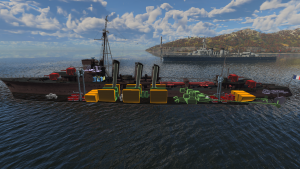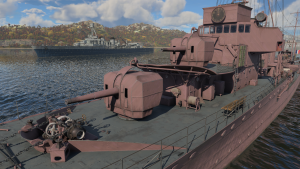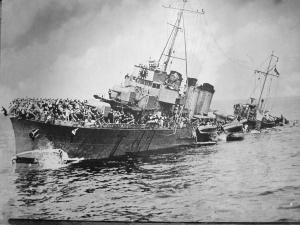Bourrasque
Contents
Description
The Bourrasque-class, Bourrasque, 1939 was a French WWII destroyer and the lead ship of her class. The Bourrasque-class destroyers were smaller and slower than the preceding Chacal-class destroyers. Bourrasque was laid down on 12th November 1923 and launched on 5th August 1925. The main armament consisted of four Canon de 130 mm Modéle 1919 in shielded single mounts covered by 10 mm thick antifragmentation armour plates on the front and sides. The secondary armament consisted of a pair of Canon de 37 mm Modéle 1925 for anti-aircraft protection and two triple launchers for 550 mm 23DT torpedoes. During her short war career, the ship participated in Operation Dynamo, where on 30th May 1940, while evacuating troops from Dunkerque, she struck a German naval mine and sunk with loss of about 500 out of the 1,100-1,200 crew and troops onboard.
Bourrasque was introduced together with French navy in Update "La Royale". The Bourrasque suffers from very slow turret rotation speed and abysmal reload of 11 seconds, which can be reduced down to 8 seconds when the crew is aced. The magazines and shell rooms are deep under the waterline, making them well-protected against detonation. Captains are advised to use SAP shells in the main guns for its penetration capability while aiming for enemy vessel weak spots such as magazines and shell rooms. The torpedoes are quite fast with max speed of 72 km/h while also having more than average range of 9 km and high explosive yield of 308 kg of TNT. The ship itself is quite mediocre, but when in good hands, it can be formidable foe, especially when relying on torpedo ambushes and close-range support roles with her powerful 130 mm cannons.
General info
Survivability and armour
The Bourrasque, like most other reserve vessels, features minimal armour, instead relying on its mobility and small size to avoid being hit. The only armour that can be found on the ship are the gun shields, reaching 10 mm thick. The ship is quite compact, meaning most shots that hit the vessel will damage or destroy a component, and the small number of crew means that prolonged combat will eventually lead to its destruction.
Mobility
The ship suffers from this rare combination of a very low maximum speed and a relatively poor turning radius. While smaller and slower destroyers typically can turn in less than 200 m stock, Bourrasque can't achieve that result until she unlocks the Rudder Replacement modification. This is an unusually bad result. But with Rudder unlocked she becomes a completely different beast, able to easily dodge torpedoes and bombs alike.
| Mobility Characteristics | |||||
|---|---|---|---|---|---|
| Game Mode | Upgrade Status | Maximum Speed (km/h) | Turn Time (s) | Turn Radius (m) | |
| Forward | Reverse | ||||
| AB | Stock | 55 | 23 | ~123.33 | ~207.2 |
| Upgraded | 75 | 31 | ~65.87 | ~139.77 | |
| RB/SB | |||||
| Upgraded | ___ | ___ | |||
Modifications and economy
Because the Bourrasque is a reserve ship, it starts with half of its modifications already unlocked. It is recommended to research the SAPBC rounds first, as this significantly increases the performance of the vessel. After unlocking the improved ammunition, Primary Armament Targeting or Torpedo Mode are vital to research, as the somewhat slow traverse speed can be offset by the former, and the latter gives the Bourrasque a deadly long range torpedo armament.
Armament
Primary armament
The Bourrasque carries a large punch for its small size, mounting 4 x 130 mm guns, that combine an average rate of fire (7.5 rounds a minute) and deadly ammunition, allowing the ship to combat all enemies it can face. Like other French ships, the guns mounted at the front of the ship have decent firing angles, but the guns at the rear have inadequate firing angles, and require the ship to be almost parallel with its opponent to get all four guns on target. Choices of ammunition are excellent for this tier, granting both devastating HE and SAPBC rounds, the former being excellent at destroying external modules, stripping enemy vessels of their crew, and igniting fires on the deck. The SAPBC rounds, on the other hand, feature a fuse which allows the round to penetrate into an enemy vessel and destroy its internal modules. These rounds make it very easy to disable an enemies engines, crippling their mobility and making them a far easier target, allowing the captain of the Bourrasque to target the ammunition storage and swiftly sending their opponent back to the hangar.
| Penetration statistics | |||||||
|---|---|---|---|---|---|---|---|
| Ammunition | Type of warhead |
Penetration @ 0° Angle of Attack (mm) | |||||
| 1,000 m | 2,500 m | 5,000 m | 7,500 m | 10,000 m | 15,000 m | ||
| OEA Mle 1932 | HE | 37 | 37 | 37 | 37 | 37 | 37 |
| OPFA Mle 1923 | SAPBC | 61 | 54 | 43 | 34 | 27 | 25 |
| Shell details | ||||||||||||
|---|---|---|---|---|---|---|---|---|---|---|---|---|
| Ammunition | Type of warhead |
Velocity (m/s) |
Projectile mass (kg) |
Fuse delay (s) |
Fuse sensitivity (mm) |
Explosive mass (TNT equivalent) (kg) |
Ricochet | |||||
| 0% | 50% | 100% | ||||||||||
| OEA Mle 1932 | HE | 725 | 34.83 | 0 | 0.1 | 3.96 | 79° | 80° | 81° | |||
| OPFA Mle 1923 | SAPBC | 725 | 32.05 | 0.035 | 5 | 1.98 | 48° | 63° | 71° | |||
Both rounds have a velocity of 725 m/s, making it easy to adjust to the SAPBC once they are unlocked. However, the muzzle velocity of these rounds is quite low compared to other reserve vessels, meaning that at a distance, enemy ships will be able to hit you before you hit them. The 130 mm OEA Mle.32 HE rounds have a lot of explosive mass, having a TNT equivalence of 3.96 kg. The 130 mm OPFA Mle.23 SAPBC rounds lose 2 kg of TNT equivalence, but gains a significant amount of penetration and the inclusion of a fuse.
Secondary armament
Like most early French destroyers, the Bourrasque features a minimal load of secondary weapons, amounting to only 2 x 37 mm guns. These 37 mm guns are not automatic, meaning they have a low rate of fire and are ineffective against aircraft, especially due to the lack of a timed fuse or proximity fuse round. These guns also have very little explosive mass and no penetration, making them ineffective against everything except small coastal vessels.
| Penetration statistics | |||||||
|---|---|---|---|---|---|---|---|
| Ammunition | Type of warhead |
Penetration @ 0° Angle of Attack (mm) | |||||
| 10 m | 100 m | 500 m | 1,000 m | 1,500 m | 2,000 m | ||
| OEA Mle 1925 | HE | 3 | 3 | 3 | 3 | 3 | 3 |
| Shell details | ||||||||||||
|---|---|---|---|---|---|---|---|---|---|---|---|---|
| Ammunition | Type of warhead |
Velocity (m/s) |
Projectile mass (kg) |
Fuse delay (m) |
Fuse sensitivity (mm) |
Explosive mass (TNT equivalent) (g) |
Ricochet | |||||
| 0% | 50% | 100% | ||||||||||
| OEA Mle 1925 | HE | 810 | 0.73 | 0 | 0.1 | 50 | 79° | 80° | 81° | |||
The 37 mm OEA Mle.25 HE rounds have a muzzle velocity of 810 m/s, allowing it to easily hit distant target. However, the explosive mass is only 50 g, meaning they do little damage, and with only 3 mm of penetration, they struggle to damage even deck-mounted weapons.
Additional armament
The Bourrasque carries a deadly torpedo armament, having 2 x triple tube 550 mm torpedo launchers mounted amidships. This gives the captain access to an extremely dangerous torpedo volley for this tier, combining some very solid torpedoes in terms of both range, speed, and explosive mass. One thing to note about these launchers is, like other French destroyers, they have horrible firing angles, requiring the vessel to show its entire side to an enemy to fire a volley. These volleys do however, guarantee the destruction of any foe encountered within 1 or 2 hits, and allow captains of the Bourrasque to destroy enemy vessels that are outside its effective firing distance.
The 550 mm Modèle 1923 DT torpedoes are extremely deadly, both with and without the Torpedo Mode modification. Without this modification, these torpedoes are lethal at short to medium ranges, having a top speed of 72 km/h and a range of 9 km, allowing it to easily intercept enemy vessels at short range. With the modification enabled, the speed is reduced to 65 km/h, but gains 4 km range, allowing it destroy enemies well beyond the effective combat distance of enemy vessels.
Usage in battles
The Bourrasque is best used to support other friendly vessels, as the low top speed and non-existent anti-aircraft battery put it at a significant disadvantage compared to other ships. Supporting your allies is a sure way to easily get kills and assists while usually avoiding incoming fire, while also reducing your chances of being hit by an enemy aircraft. The easiest way to destroy enemy vessels with the Bourrasque is to simply take out the enemies running gear, then swiftly sending them back to the hangar by destroying their ammo racks. If you are finding it hard to hit the magazines, do not fret, as the large rounds this ship fires allows it to quickly dispatch crew from enemy vessels. The lack of protection, small crew, and the compact nature of this ship means that being hit is usually quite fatal, regardless of where the enemy hits. Always try to avoid incoming fire by 'wiggling' and only expose the side of your ship in close quarters battles, where it is most important to get all guns on target. The small turning circle of the ship allows it to easily dodge torpedoes, so long as you are aware of your surroundings.
Enemies worth noting: Enemy vessels with autocannons, like the 40 mm Pom Pom or Bofors, or even 20 mm guns can easily strip the Bourrasque of crew and disable its internal and external components, so be mindful of these enemies. Guns of these type are usually not carried on ships at this tier, but there are a few exceptions, such as the British HMS Vega and HMS Calpe, the German Type 1934A-class destroyers, and all Soviet destroyers. The easiest way to avoid getting hit by these guns is to sit outside their firing range, at about 4 km, allowing you to fight on equal grounds with these vessels.
As with any bluewater vessel, a single coastal vessel can spell doom for the Bourrasque. Always try to keep a small island or piece of wreckage between you and coastal vessels, so you can easily avoid being torpedoes. Do not rely on your 37 mm guns to destroy these, as the lack of damage struggles even against some coastal boats. Instead, try to keep a bit of distance to allow your 130 mm guns to depress enough to dispatch the enemy boat.
Pros and cons
Pros:
- Tight turning circle makes it easy to dodge torpedoes and change direction quickly
- Small size makes it easier to avoid incoming fire
- Deadly torpedo armament
- 130 mm guns are extremely effective against any enemy encountered
Cons:
- Rear mounted guns have limited firing angles
- Torpedo launchers have very poor firing angles
- No anti-aircraft armament
- Secondary weapons are inadequate against most targets
- No protection and small crew
- Below average top speed
History
Bourrasque-class
The Bourrasque-class destroyers were a group of twelve ships built during the 1920s under a 1922 programme. This programme was a part of a larger programme designed to completely modernise the French Navy post-World War I, and while they were smaller and slower than the larger Chacal class, they were still comparable to contemporary destroyers. These ships reached 2,000 t under full load, and under standard load reached 1,319 t. The Bourrasque-class ships were 106 m (347ft, 9in) long, a beam of 9.64 m (31ft, 8in), and a 4.3 m (14ft, 1in) draught. Each ship was powered by two steam turbines, each turbine driving a propeller shaft. Both turbines were provided steam by three boilers each. The turbines were rated at a combined power of 31,000 horsepower, propelling the ships up to 33 knots (66 km/h), and with the fuel on board, could travel 5,600 km (3,000 nautical miles) at a speed of 15 kn (28 km/h). The armament of the Bourrasque-class consisted of 4 x 130 mm Mle. 19 for their main guns, 2 x 37 mm Mle. 25 for their secondary armament, and their anti-aircraft battery consisted of 4 x 13.2 mm machine guns in single mounts. They also had 2 x triple 550 mm torpedo launchers and 2 x depth charge chutes, allowing them to carry a total of sixteen 200 kg depth charges. The Bourrasque-class was in service from the mid-1920s all the way to the '50s, serving in both the Free French Navy and the Vichy French Navy, as well as serving in the Polish Navy and the Royal Navy.
Bourrasque
The Bourrasque, the lead ship of the class, was laid down on 12th November 1923 and was completed on the 23rd September 1926, entering service on the same day of her completion. In 1931, the Bourrasque-class underwent a refit, adding 1 x 75 mm Mle. 24, 2 x 37 mm Mle. 25 cannons, and 2 x twin-mounted 13.2 mm machine guns. Another refit in 1939-1940 introduced the British Type 123 sonar to the vessels. Bourrasque participated in Operation Dynamo, the Dunkirk Evacuation, where she was struck by a French mine which then detonated the depth charges, resulting in a massive explosion, killing roughly 500 of the 1,100 troops onboard.
Media
- Skins
See also
- Similar ships from other nations
External links
- [Wikipedia] French destroyer Bourrasque
- [Dunkirk 1940 - The Before, The Reality, The Aftermath] The French Destroyer Bourrasque
- [Navypedia] BOURRASQUE destroyers (1926 - 1928)
| Ateliers et Chantiers de France (ACF) | |
|---|---|
| Destroyers | |
| Bourrasque-class | Bourrasque |
| Aigle-class | Aigle |
| Vauquelin-class | Vauquelin |
| Le Fantasque-class | Le Triomphant |
| France destroyers | |
|---|---|
| Bourrasque-class | Bourrasque · Tornade |
| Chacal-class | Chacal · Leopard · Panthere |
| Aigle-class | Aigle · Vautour · Milan |
| Vauquelin-class | Vauquelin |
| Le Fantasque-class | Le Malin · Le Triomphant |
| Mogador-class | Mogador |
| Hunt-class | La Combattante |
| Trophies | Germany |
| Desaix-class¹ | Kleber |
| Type 1936 | Marceau |
| Italy | |
| Chateaurenault-class² | Guichen |
| Modified: ¹Type 1934A-class destroyers · ²Capitani Romani-class cruisers | |








